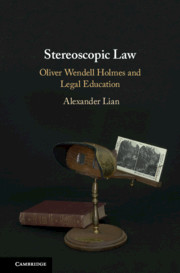Book contents
- Stereoscopic Law
- Stereoscopic Law
- Copyright page
- Dedication
- Epigraph
- Contents
- Preface
- Acknowledgements
- Introduction
- Part I Law and the Legal Profession
- Part II The Inner Path of the Common Law
- Part III The Purely Legal Point of View
- Part IV Thirteen Ways of Looking at the Bad Man
- Part V The Theory of Legal Study
- Conclusion
- Index
Conclusion
Published online by Cambridge University Press: 23 January 2021
- Stereoscopic Law
- Stereoscopic Law
- Copyright page
- Dedication
- Epigraph
- Contents
- Preface
- Acknowledgements
- Introduction
- Part I Law and the Legal Profession
- Part II The Inner Path of the Common Law
- Part III The Purely Legal Point of View
- Part IV Thirteen Ways of Looking at the Bad Man
- Part V The Theory of Legal Study
- Conclusion
- Index
Summary
The Conclusion uses Karl N. Llewellyn’s“What Price Contract? – An Essay in Perspective” to bring together many of the dominant themes discussed in the book. For three-dimensional law to arise legal scholars must be more refined in their perception of ideas – civilized growth, in Holmes’s view, depended on that. Holmes’s sensitivity to multivalency becomes then the leading goal of a well-wrought legal pedagogy. The more law could muster feeling, the more civilized the nation would grow. At least that was Holmes’s hope as he expressed it to Harold J. Laski.
Keywords
- Type
- Chapter
- Information
- Stereoscopic LawOliver Wendell Holmes and Legal Education, pp. 488 - 506Publisher: Cambridge University PressPrint publication year: 2020

